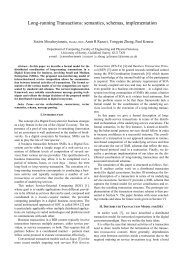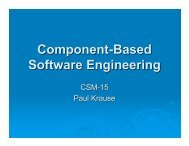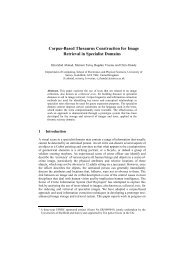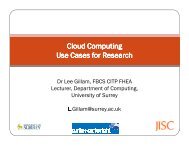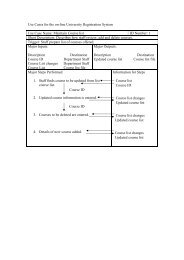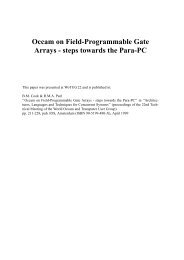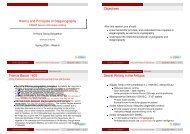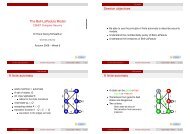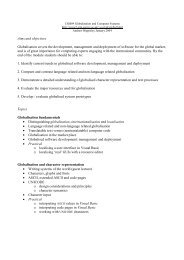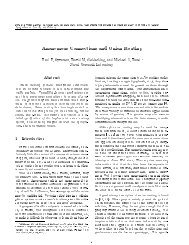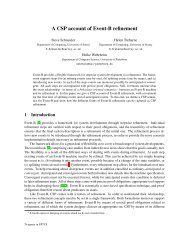ANSWERS - Department of Computing - University of Surrey
ANSWERS - Department of Computing - University of Surrey
ANSWERS - Department of Computing - University of Surrey
You also want an ePaper? Increase the reach of your titles
YUMPU automatically turns print PDFs into web optimized ePapers that Google loves.
CS/183/23/SS08<br />
SOLUTIONS<br />
UNIVERSITY OF SURREY ©<br />
BSc Programmes in <strong>Computing</strong><br />
Level 1 Examination<br />
CS183: Systems Analysis and Design<br />
Time allowed: 2 hours Spring Semester 2008<br />
********************************************************<br />
<strong>ANSWERS</strong><br />
********************************************************<br />
*IMPORTANT*<br />
WRITE YOUR URN HERE …………………………………………………<br />
THIS QUESTION PAPER MUST BE HANDED IN WITH YOUR<br />
ANSWERBOOK AT THE END OF THE EXAMINATION<br />
SEE NEXT PAGE
CS/183/23/SS08<br />
- Page 2 -<br />
SOLUTIONS<br />
SECTION A - Answer ALL questions in this section [one mark each].<br />
*(answers are in bold)*<br />
1. The systems development life cycle (SDLC) is the process <strong>of</strong> _____.<br />
A. building an information system<br />
B. delivering an information system to a client<br />
C. designing an information system<br />
D. understanding how an information system can support business needs<br />
E. all <strong>of</strong> the above<br />
2. In which phase <strong>of</strong> the SDLC is the system proposal developed?<br />
A. analysis<br />
B. design<br />
C. implementation<br />
D. planning<br />
E. system delivery<br />
3. The systems development methodology that emphasizes simple, iterative,<br />
application development that provides rapid feedback to users on an ongoing<br />
basis, with continuous development and testing is ________.<br />
A. modular development<br />
B. rapid application development<br />
C. prototyping<br />
D. agile development<br />
E. throwaway prototyping<br />
SEE NEXT PAGE
CS/183/23/SS08<br />
- Page 3 -<br />
SOLUTIONS<br />
4. The primary advantage <strong>of</strong> the Waterfall Development methodology is that _____.<br />
A. a version <strong>of</strong> the system is quickly delivered into the users' hands<br />
B. requirements evolve through users' feedback about the system<br />
C. features and functionality <strong>of</strong> the system are explored through simple models<br />
D. requirements are completely specified and held relatively constant prior<br />
to programming<br />
E. there is a long time lapse prior to completion<br />
5. The principal disadvantage(s) with the waterfall development methodology is<br />
(are) _____.<br />
A. a long time elapses between completion <strong>of</strong> the system proposal and the<br />
delivery <strong>of</strong> the system<br />
B. it identifies system requirements long before programming begins<br />
C. it minimizes changes to the requirements as the project proceeds<br />
D. the design must be completely specified on paper before programming begins<br />
E. a long time elapses between completion <strong>of</strong> the system proposal and the<br />
delivery <strong>of</strong> the system and the design must be completely specified<br />
(usually on paper) before programming begins<br />
6. The analysis phase <strong>of</strong> the SDLC answers _____.<br />
A. who will build the system and when will it be used<br />
B. who will the system be for, what the system will do, when will it be used,<br />
and where will it be used<br />
C. why build the system, what the system will be, and how the system will work<br />
D. why build the system, who will the system be for, when will it be used, and<br />
how the system will work<br />
E. why build the system, who will the system be for, when will it be used, and<br />
where will it be used<br />
SEE NEXT PAGE
CS/183/23/SS08<br />
- Page 4 -<br />
SOLUTIONS<br />
7. If the system under development will employ technology with which the analysts<br />
and programmers are unfamiliar, the most appropriate methodology to employ is:<br />
A. Waterfall Development<br />
B. Throw-Away Prototyping<br />
C. Parallel Development<br />
D. Phased Development<br />
E. Prototyping<br />
8. The _____ development methodology is never recommended when system<br />
reliability is critical.<br />
A. parallel<br />
B. phased<br />
C. prototyping<br />
D. throwaway prototyping<br />
E. waterfall<br />
9. Which <strong>of</strong> the following systems development methodologies involves developing<br />
the system in a series <strong>of</strong> sequential versions?<br />
A. Parallel Development<br />
B. Phased Development<br />
C. Prototyping<br />
D. Throw-Away Prototyping<br />
E. Waterfall Development<br />
10. _____ development is a structured design methodology that divides the project<br />
into a series <strong>of</strong> distinct subprojects that can be designed and implemented<br />
together.<br />
A. Parallel<br />
B. Phased<br />
C. Prototyping<br />
D. Rapid Application<br />
E. Throwaway Prototyping<br />
SEE NEXT PAGE
CS/183/23/SS08<br />
- Page 5 -<br />
SOLUTIONS<br />
11. The _____ is generated by the department or person that has an idea for a new<br />
information system.<br />
A. feasibility analysis<br />
B. gradual refinement<br />
C. project sponsor<br />
D. system request<br />
E. work plan<br />
12. The information gathering technique that is most effective in combining<br />
information from a variety <strong>of</strong> perspectives, building consensus, and resolving<br />
discrepancies is ________<br />
A. interviews.<br />
B. JAD (Joint Application Design) sessions.<br />
C. questionnaires.<br />
D. document analysis.<br />
E. observation.<br />
13. In a JAD (Joint Application Design) Session, which <strong>of</strong> the following is NOT a<br />
proper role for the facilitator?<br />
A. Assist the group in understanding the analysis techniques.<br />
B. Document group output on a public display.<br />
C. Ensure that the JAD session agenda is followed.<br />
D. Cast the deciding vote on controversial issues.<br />
E. Guide the discussion.<br />
14. During document analysis the systems analyst learns that users in the purchasing<br />
department have created their own forms. This is a clear sign that the _____.<br />
A. as-is system is meeting user needs<br />
B. department was overlooked during the interview process<br />
C. process does not need improvements<br />
D. system needs to be changed<br />
E. users in the department are innovative<br />
SEE NEXT PAGE
CS/183/23/SS08<br />
- Page 6 -<br />
SOLUTIONS<br />
15. During an interview, the following question is asked; "How many times during a<br />
typical week does a customer complain about inadequate service following a<br />
sale?" This question is an example <strong>of</strong> a(n) _____________<br />
A. probing question.<br />
B. open-ended question.<br />
C. closed-ended question.<br />
D. inappropriate question.<br />
E. opinion question.<br />
16. A systems analyst has prepared an interview that begins with specific, detailed<br />
questions, and then asks the interviewee to make general statements about policies<br />
and procedure <strong>of</strong> the business process. This is a(n) _____ interview structure.<br />
A. bottom up<br />
B. closed<br />
C. open ended<br />
D. probing<br />
E. top down<br />
17. The examination <strong>of</strong> existing paperwork in order to better understand the as-is<br />
system is an example <strong>of</strong> what information-gathering strategy?<br />
A. document analysis<br />
B. interviewing<br />
C. joint application design (JAD) sessions<br />
D. observation<br />
E. questionnaires<br />
SEE NEXT PAGE
CS/183/23/SS08<br />
- Page 7 -<br />
SOLUTIONS<br />
18. The information gathering technique that enables the analyst to collect facts and<br />
opinions from a wide range <strong>of</strong> geographically dispersed people quickly and with<br />
the least expense is the _____.<br />
A. document analysis<br />
B. interview<br />
C. JAD session<br />
D. observation<br />
E. questionnaire<br />
19. The systems development methodology(methodologies) that is(are) most effective<br />
when the user requirements are particularly unclear is(are) _______.<br />
A. waterfall development<br />
B. parallel development<br />
C. phased development<br />
D. prototyping<br />
E. prototyping and throwaway prototyping<br />
20. Which <strong>of</strong> the following development strategies is preferred when the business<br />
need is common and time is a limiting factor?<br />
A. in-house, custom development<br />
B. purchased s<strong>of</strong>tware<br />
C. end-user development<br />
D. outsourcing<br />
E. None <strong>of</strong> the above<br />
21. The foundation <strong>of</strong> the Unified Modelling Language is the _____________<br />
A. use case.<br />
B. object.<br />
C. activity diagram.<br />
D. message.<br />
E. method.<br />
SEE NEXT PAGE
CS/183/23/SS08<br />
- Page 8 -<br />
SOLUTIONS<br />
22. The Unified Modeling Language diagramming technique that illustrates the<br />
objects and messages involved in a use case is the _____________<br />
A. use case diagram.<br />
B. sequence diagram.<br />
C. class diagram.<br />
D. statechart diagram.<br />
E. None <strong>of</strong> the above<br />
23. Each use case describes how the system reacts to a(n) _____ that occurs to trigger<br />
the system.<br />
A. activity<br />
B. event<br />
C. model<br />
D. session<br />
E. transition<br />
24. Which <strong>of</strong> the following is <strong>of</strong>ten left out by end users when identifying elements<br />
within Use Case steps?<br />
A. analytical analysis <strong>of</strong> the identity elements<br />
B. JAD session classification<br />
C. requirements definition<br />
D. role play analysis<br />
E. seldom-used activities or special cases<br />
25. When developing use cases, the project team first identifies the _______.<br />
A. managers that supervise the use case department<br />
B. place where the use case occurs<br />
C. time the use case begins<br />
D. trigger that causes the use case to occur<br />
E. users who perform the use case<br />
SEE NEXT PAGE
CS/183/23/SS08<br />
- Page 9 -<br />
SOLUTIONS<br />
26. Validating that the use case is correct and complete is the major activity<br />
performed during which step <strong>of</strong> the Writing Use Case Reports process?<br />
A. identify elements within steps<br />
B. identify the major steps within each use case<br />
C. identify the use cases<br />
D. confirm the use cases<br />
E. write the use case report<br />
27. Which <strong>of</strong> the following diagramming symbols represents a generalization<br />
relationship in a use case diagram?<br />
A.<br />
B.<br />
C.<br />
D.<br />
E.<br />
28. Which <strong>of</strong> the following relationships represent an enhancement <strong>of</strong> the<br />
functionality <strong>of</strong> the use case to cover optional behaviour?<br />
A. association relationship<br />
B. extend relationship<br />
C. include relationship<br />
D. generalization relationship<br />
E. optional relationship<br />
SEE NEXT PAGE
CS/183/23/SS08<br />
- Page 10 -<br />
SOLUTIONS<br />
29. Buying in packaged s<strong>of</strong>tware as a design strategy is good if _____.<br />
A. in-house functional and technical experience exists<br />
B. the business need is common<br />
C. there is a desire to build in-house skills<br />
D. the timeframe is flexible<br />
E. the business need is core to the business<br />
30. A custom development design strategy is NOT good for _____.<br />
A. building technical skills<br />
B. creating functional knowledge in-house<br />
C. improving creativity<br />
D. increasing flexibility<br />
E. lowering risk<br />
31. A disadvantage <strong>of</strong> outsourcing the application development process is that the<br />
organization may ______.<br />
A. build technical skills and functional knowledge in-house<br />
B. lose control over confidential information<br />
C. create a unique business need<br />
D. remove all risk from the project<br />
E. make strategic changes during implementation<br />
32. Manipulating certain parameters to refine the way features work in a s<strong>of</strong>tware<br />
package is called ______.<br />
A. a workaround<br />
B. adjustment<br />
C. customization<br />
D. feature adjustability<br />
E. parameterizing<br />
SEE NEXT PAGE
CS/183/23/SS08<br />
- Page 11 -<br />
SOLUTIONS<br />
33. An advantage <strong>of</strong> purchasing packaged s<strong>of</strong>tware is that the organization may<br />
______.<br />
A. accept functionality that is not a perfect fit<br />
B. build technical skills and functional knowledge<br />
C. have developers climb the knowledge ladder<br />
D. make strategic changes during implementation<br />
E. save money on the purchase<br />
34. “A-part-<strong>of</strong>” or “has-parts” relationship represents a(n) ______ relationship.<br />
A. generalization<br />
B. association<br />
C. aggregation<br />
D. subsetting<br />
E. vague<br />
35. “A-kind-<strong>of</strong>” relationship represents a(n) ______ relationship.<br />
A. generalization<br />
B. association<br />
C. aggregation<br />
D. subsetting<br />
E. vague<br />
36. Which <strong>of</strong> the following would not be an appropriate class name?<br />
A. student<br />
B. patient<br />
C. James<br />
D. customer<br />
E. doctor<br />
SEE NEXT PAGE
CS/183/23/SS08<br />
- Page 12 -<br />
SOLUTIONS<br />
37. A(n) _____ describes information about an object.<br />
A. attribute<br />
B. behaviour<br />
C. operation<br />
D. message<br />
E. instance<br />
38. Which <strong>of</strong> the following is NOT one <strong>of</strong> the four basic functions <strong>of</strong> a computer<br />
application?<br />
A. application logic<br />
B. data access logic<br />
C. data storage<br />
D. networking logic<br />
E. presentation logic<br />
39. Assume that your network has a server and three clients, the network is an<br />
example <strong>of</strong> a(n) _____.<br />
A. 4-tiered architecture<br />
B. single-tiered architecture<br />
C. three-tiered architecture<br />
D. tierless architecture<br />
E. two-tiered architecture<br />
40. A server in a typical client-server based system performs which <strong>of</strong> the following<br />
application functions?<br />
A. application logic<br />
B. data access logic and presentation logic<br />
C. data storage and data access logic<br />
D. data storage and presentation logic<br />
E. presentation logic and application logic<br />
SEE NEXT PAGE
CS/183/23/SS08<br />
- Page 13 -<br />
SOLUTIONS<br />
41. What is one primary problem with server-based computing architectures?<br />
A. Servers are no longer made by hardware vendors.<br />
B. Client terminals are no longer made by hardware vendors.<br />
C. As users place heavier demands on the server, it is costly to increase<br />
server capacity.<br />
D. It is difficult to maintain security in the server-based environment.<br />
E. Servers are difficult to connect to client terminals.<br />
42. Which <strong>of</strong> the following is NOT one <strong>of</strong> the fundamental computing architectures?<br />
A. Client-based computing<br />
B. System-based computing<br />
C. Server-based computing<br />
D. Client-server based computing<br />
43. An analyst depicts the static view <strong>of</strong> an information system with ______.<br />
A. use-case models<br />
B. structural models<br />
C. behavioural models<br />
D. interaction diagrams<br />
E. statechart diagrams<br />
44. On a sequence diagram, an object name <strong>of</strong> aStudent:List would indicate that<br />
_____.<br />
A. aStudent is an instance <strong>of</strong> the List class<br />
B. List is an instance <strong>of</strong> the Student class<br />
C. List is a method <strong>of</strong> the Student class<br />
D. the Student and List objects are combined for that step in the sequence<br />
diagram<br />
E. a message is being passed from the Student class to the List class<br />
SEE NEXT PAGE
CS/183/23/SS08<br />
- Page 14 -<br />
SOLUTIONS<br />
45. In a sequence diagram, an analyst draws a lifeline with an X at the end. This<br />
lifeline represents _____.<br />
A. a message that cannot be delivered<br />
B. an object that is destroyed at a point in time<br />
C. a message that is delivered at a point in time<br />
D. an object that is complete at a point in time<br />
E. an object that arrives at its final destination<br />
46. The UML diagramming technique that shows the different state that a single<br />
object passes through in reponse to events is a(n) _____ diagram.<br />
A. class<br />
B. sequence<br />
C. behavioural state machine<br />
D. use case<br />
E. component<br />
47. In a sequence diagram, an analyst draws a long box shape on top <strong>of</strong> a lifeline. This<br />
box represents _____.<br />
A. the time in which the object is exchanging messages<br />
B. the time in which the object does not exist<br />
C. a transition from one state to another<br />
D. the encapsulation <strong>of</strong> the object<br />
E. the time in which the object exists<br />
48. The order <strong>of</strong> messages on a sequence diagram goes from ________ .<br />
A. right to left<br />
B. bottom to top<br />
C. left to right<br />
D. top to bottom<br />
E. left to right, top to bottom<br />
SEE NEXT PAGE
CS/183/23/SS08<br />
- Page 15 -<br />
SOLUTIONS<br />
49. The process <strong>of</strong> building new systems by combining packaged s<strong>of</strong>tware, existing<br />
legacy systems, and new s<strong>of</strong>tware written to integrate everything together is called<br />
______.<br />
A. customization<br />
B. formal methodology<br />
C. outsourcing<br />
D. systems integration<br />
E. workaround<br />
50. Which <strong>of</strong> the following is not a fundamental way to approach the creation <strong>of</strong> a<br />
new information system?<br />
A. develop a custom application in-house<br />
B. rely on an external vendor to build the system<br />
C. purchase a s<strong>of</strong>tware package and customize it<br />
D. rely on end-users to develop it themselves<br />
E. all <strong>of</strong> the above are ways to create new information systems<br />
51. An advantage <strong>of</strong> custom development is that the organization can _____.<br />
A. accept functionality that is not a perfect fit<br />
B. build technical skills and functional knowledge<br />
C. install in a short period <strong>of</strong> time<br />
D. remove all risk from the project<br />
E. save money on the purchase<br />
52. A(n) _____ file stores past transactions that may no longer be needed, is usually<br />
stored <strong>of</strong>f-line, and can be accessed on an as-needed basis.<br />
A. audit<br />
B. history<br />
C. look-up<br />
D. master<br />
E. transaction<br />
SEE NEXT PAGE
CS/183/23/SS08<br />
- Page 16 -<br />
SOLUTIONS<br />
53. The process <strong>of</strong> adding redundancy back into a physical data model is known as<br />
_____.<br />
A. balancing<br />
B. clustering<br />
C. denormalization<br />
D. indexing<br />
E. normalization<br />
54. The most efficient tables in a relational database in terms <strong>of</strong> storage space have<br />
_____.<br />
A. no redundant data and few null values<br />
B. no redundant data and plenty <strong>of</strong> null values<br />
C. redundant data and few null values<br />
D. redundant data and plenty <strong>of</strong> null values<br />
E. repeat customer information<br />
55. ______ is the general template used to define and create specific instances or<br />
objects.<br />
A. a class<br />
B. inheritance<br />
C. a message<br />
D. polymorphism<br />
E. a method<br />
56. ______ is essentially a function or procedure call from one object to another, and<br />
is the information sent to objects to trigger methods.<br />
A. encapsulation<br />
B. information hiding<br />
C. inheritance<br />
D. a message<br />
E. polymorphism<br />
SEE NEXT PAGE
CS/183/23/SS08<br />
- Page 17 -<br />
SOLUTIONS<br />
57. The most common threat to a computer system is posed by _________.<br />
A. internal hackers.<br />
B. industrial espionage.<br />
C. device failure.<br />
D. viruses.<br />
E. natural disasters.<br />
58. When all files are regularly tested for worms, bugs, and illicit programs; this is an<br />
example <strong>of</strong> _____ requirements.<br />
A. access control<br />
B. encryption and authentication<br />
C. portability<br />
D. technical environment<br />
E. virus control<br />
59. A file that stores information on who, when, and how data was altered is a(n)<br />
______ file.<br />
A. audit<br />
B. history<br />
C. look-up<br />
D. master<br />
E. transaction<br />
60. The normalization process is performed primarily to increase the database's<br />
___________<br />
A. storage efficiency.<br />
B. indexing scheme.<br />
C. access speed.<br />
D. multiple dimensions.<br />
E. none <strong>of</strong> the above.<br />
SEE NEXT PAGE
CS/183/23/SS08<br />
- Page 18 -<br />
SOLUTIONS<br />
61. The ability <strong>of</strong> the same message to be interpreted differently by different classes<br />
<strong>of</strong> objects is referred to as _____________<br />
A. encapsulation.<br />
B. polymorphism.<br />
C. inheritance.<br />
D. association.<br />
E. None <strong>of</strong> the above.<br />
62. When the analyst is evaluating a data model to ensure that all fields in a record<br />
depend fully on the entire primary key, which step <strong>of</strong> normalization is being<br />
performed?<br />
A. Base normal form<br />
B. First normal form<br />
C. Second normal form<br />
D. Third normal form<br />
E. Cannot tell from the above information.<br />
63. If the logical data model contains fields that depend on another non-primary key<br />
field, then it is in violation <strong>of</strong> the rules <strong>of</strong> _____.<br />
A. base normal form<br />
B. first normal form<br />
C. non-normal form<br />
D. second normal form<br />
E. third normal form<br />
64. The process <strong>of</strong> ensuring that values linking tables together through the primary<br />
and foreign keys are valid and correctly synchronized is _____.<br />
A. hierarchical integrity<br />
B. primary integrity<br />
C. table integrity<br />
D. referential unity<br />
E. referential integrity<br />
SEE NEXT PAGE
CS/183/23/SS08<br />
- Page 19 -<br />
SOLUTIONS<br />
65. In order to reduce the number <strong>of</strong> joins that must be performed in a query and to<br />
increase the speed <strong>of</strong> data access, the data analyst can _____ the physical model.<br />
A. cluster<br />
B. denormalize<br />
C. index<br />
D. normalize<br />
E. optimize<br />
66. The first step in the Design Phase is to _____.<br />
A. convert logical process and data models to physical<br />
B. create the deliverable<br />
C. design the architecture<br />
D. design the inputs and outputs<br />
E. present design alternatives<br />
67. The plan for the creation <strong>of</strong> the hardware and s<strong>of</strong>tware infrastructure is commonly<br />
called _____.<br />
A. architecture design<br />
B. hardware specifications<br />
C. s<strong>of</strong>tware specifications<br />
D. network model<br />
E. presentation logic<br />
68. The number <strong>of</strong> errors found is likely to be highest in the _____ stage <strong>of</strong> testing.<br />
A. unit test<br />
B. integration test<br />
C. system test<br />
D. acceptance test (alpha)<br />
E. acceptance test (beta)<br />
SEE NEXT PAGE
CS/183/23/SS08<br />
- Page 20 -<br />
SOLUTIONS<br />
69. _____ is the development <strong>of</strong> all parts <strong>of</strong> the new system including the s<strong>of</strong>tware,<br />
documentation, and initiation <strong>of</strong> new operating procedures.<br />
A. Construction<br />
B. Design<br />
C. Documentation<br />
D. Management<br />
E. Testing<br />
70. Training for a business system should focus on _____.<br />
A. all the capabilities <strong>of</strong> the new system<br />
B. complex computerized modules and code<br />
C. helping the users to accomplish their jobs<br />
D. how to use the system<br />
E. not using the system<br />
[Total for Section A: 70 marks]<br />
SEE NEXT PAGE FOR SECTION B
CS/183/23/SS08<br />
- Page 21 -<br />
SOLUTIONS<br />
SECTION B - Answer ONE question from this section.<br />
1. This question is about Unified Modeling Language (UML) Functional Models<br />
(a)<br />
i) An overview use case diagram is a use case diagram that does not go into great<br />
detail, but instead attempts to show only the high level overview <strong>of</strong> the<br />
requirements. Typically an overview use case diagram is created early in the<br />
process <strong>of</strong> understanding the system requirements.<br />
[2 marks]<br />
(b)<br />
ii) The Doctor, Patient and Management are called ‘actors’ in this kind <strong>of</strong> diagram.<br />
This term is particularly appropriate because they refer to ‘roles’ and not<br />
necessarily particular people. In a movie, a movie actor plays a part, or role. For<br />
example Patient refers to the role <strong>of</strong> being a patient, and not any particular one<br />
patient. Indeed, here, there are many such possible patients, shown on the diagram<br />
as one Patient actor (i.e. role).<br />
[4 marks]
CS/183/23/SS08<br />
- Page 22 -<br />
SOLUTIONS<br />
Use cases are shown in this diagram as ovals. The ‘New Patient’ and ‘Old Patient’ are<br />
specialised actors, which are generalised (shown by an arrow) to the ‘Patient’ actor. The<br />
‘Update Patient Information’ use case extends the ‘Make Old Patient Appointment’ use<br />
case because sometimes the patient information is updated (the New Patient doesn’t have<br />
this because a record cannot be updated before it is created). Similarly, the ‘Make Payment<br />
Arrangements’ use case is an extension <strong>of</strong> the generalised (for both old and new patients)<br />
Make Appointment use case, because sometimes new payment arrangements are made.<br />
The Make ‘Old’ and ‘New’ Patient Appointment use cases are generalised to the ‘Make<br />
Appointment’ use case. A new patient record is always created by the ‘Create New<br />
Patient’ use case, when an appointment is made for a New patient, using the ‘Make New<br />
Patient Appointment’ use case, so is used here. Similarly, when the<br />
Management ‘Produce Schedule Information’, and a Doctor ‘Records Availability’, the<br />
Manage Schedule use case is always invoked, so is also used here. (Note:<br />
many use case diagrams do not use the * multiplicity syntax, so no marks will be lost if<br />
they are not included here.)<br />
Use Cases 1 mark each+1 mark for each actor+1 mark for each generalisation+ 1 mark for<br />
each extend or include =[21 marks]<br />
(c)
CS/183/23/SS08<br />
- Page 23 -<br />
SOLUTIONS<br />
Specialised actors for GP(General Practitioner) and Specialist can be added as shown,<br />
generalised to Doctor, using the generalisation arrow – see diagram above [3 marks].<br />
2. This question is about Requirements Determination (Requirements Gathering).<br />
(a)<br />
scribe (or scribes): assists the facilitator by recording notes, making copies<br />
(sometimes using CASE tools for this). Basically a scribe acts as a secretary and does<br />
not actually take part in the discussion.<br />
facilitator: a person who sets the meeting agenda and guides the discussion, but does<br />
not join in the discussion as a participant. He/she does not provide ideas or opinions<br />
on the topics under discussion, remaining neutral throughout the session. However,<br />
the facilitator does write group points and conclusions on a board/flipchart for all to<br />
see. The facilitator must be an expert in both group process techniques and IS analysis<br />
and design techniques.<br />
agenda merry-go-round: this is when a group member keeps returning to the same<br />
issue every few minutes and won't let go. One solution is to let the person have 5<br />
minutes to ramble on, while every point is carefully written on a flip-chart. Then at<br />
future occasions, the flip chart can be referred to whenever the person raises the point<br />
again.<br />
side discussions: this is a problem in a JAD session, when some participants persist in<br />
private discussions with the person sitting next to them rather than taking part openly<br />
in the group session. This can <strong>of</strong>ten be resolved by walking over to where they are<br />
sitting.<br />
violent agreement: is when participants really agree on the issues, but don't realise<br />
they are agreeing because they are using different terms. For example, one might<br />
argue that a glass is half full, whereas the other might be arguing that it is half empty.<br />
To solve this, the facilitator has to translate the terms into different words to find<br />
common ground so that the parties realise that they really agree.<br />
[2 marks for each = 10 marks]<br />
(b)<br />
Interviews:<br />
(1) Selecting interviewees: make schedule or list <strong>of</strong> all people to be interviewed.<br />
(2) Designing interview questions: designing closed-ended, open-ended, or probing<br />
questions.<br />
(3) Preparing for the interview: create interview plan, anticipating possible answers<br />
and providing follow-up questions.<br />
(4) Conducting the interview: build up rapport and trust, explain why the questions<br />
are being asked, present an unbiased view, take careful notes, and make sure every<br />
answer is understood.<br />
(5) Post-interview follow-up: prepare interview report, <strong>of</strong>ten also sending this to the<br />
interviewees for approval/clarification (with thanks).<br />
[one mark for each listed plus one for each explanation = 10 marks]<br />
(c) List the other THREE main information-gathering techniques used in the analysis<br />
phase.<br />
(1) Document analysis<br />
(2) Questionnaires<br />
(3) Observation
CS/183/23/SS08<br />
- Page 24 -<br />
SOLUTIONS<br />
[one mark for each = 3 marks]<br />
(d) JAD Sessions and Interviews provide the greatest amount <strong>of</strong> detail (greatest depth).<br />
They both also help the analyst to understand the reasons behind the information<br />
provided. They are useful for obtaining not only facts and figures, but also an<br />
understanding <strong>of</strong> why those facts and opinions exist. (In contrast, document analysis<br />
and observation really only are useful for obtaining facts. Questionnaires can provide<br />
medium depth, regarding both facts and opinions, but obtain little understanding <strong>of</strong><br />
why.)<br />
[4 marks]<br />
(e) Interviews and JAD Sessions are the most costly; both having what might be called<br />
‘moderate’ costs. JAD Sessions are much more expensive initially, because many<br />
users and highly-paid managers and consultants need to be away from their <strong>of</strong>fices for<br />
a long period <strong>of</strong> time, BUT since JAD Sessions can significantly reduce the time<br />
spent in design and information integration, that cost is <strong>of</strong>fset in the long term.<br />
Interviews have moderate costs because although personnel are removed from their<br />
<strong>of</strong>fices, it is generally one at a time, and therefore has less impact on productivity.<br />
[3 marks]<br />
EXAMINER: Dr J. Y. Clark



